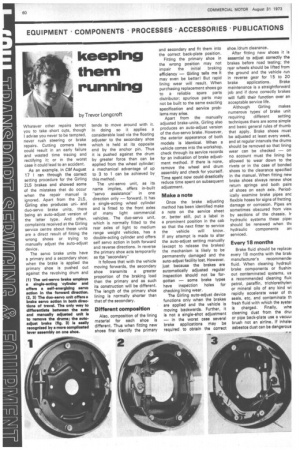keeping them running
Page 56

If you've noticed an error in this article please click here to report it so we can fix it.
by Trevor Longcroft
Whatever other repairs tempt you to take short cuts, though I advise you never to be tempted, never rush steering or brake repairs. Cutting corners here could result in an early failure and wasted time tracing and rectifying it; or in the worst case it could lead to an accident.
As an example, in CM August 17 I ran through the correct setting procedure for the Girling 2LS brakes and showed some of the mistakes that do occur when the repair manual is ignored. Apart from the 2LS, Girling also produces uniand duo-servo brake units, there being an auto-adjust version of the latter type. And often, complaints received at the Girling service centre about these units are a direct result of fitting the wrong shoes or trying to manually adjust the auto-adjust device.
The servo brake units have a primary and a secondary shoe; when the brake is applied the primary shoe is pushed out against the revolving drum and tends to move around with it. In doing so it applies a considerable load via the floating adjuster to the secondary shoe which is held at its opposite end by the anchor pin. Thus it is pushed against the drum by greater force than can be applied from the wheel cylinder; a mechanical advantage of up to 3 to 1 can be achieved • by this method.
The uni-servo unit, as its name implies, offers in-built "servo assistance" in one direction only — forward. It has a single-acting wheel cylinder and is fitted to the front axles of many light commercial vehicles. The duo-servo unit, which is normally fitted to the rear axles of light to medium range weight vehicles, has a double-acting cylinder and offers self servo action in both forward and reverse directions. In reverse the primary shoe acts temporarily as tile -secondary"
It follows that with the vehicle moving forwards, the secondary shoe transmits a greater proportion of the braking load than the primary and as such its construction will be different. The length of the primary shoe lining is normally shorter than that of the secondary.
Different composition
Also, composition of the lining materiel for each shoe is different. Thus when fitting new shoes first identify the primary and secondary and fit them into the correct back-plate position. Fitting the primary shoe in the wrong position may not impair the initial braking efficiency — Girling tells me it may even be better! But rapid lining wear will result. When purchasing replacement shoes go to a reliable spare parts distributor; spurious parts may not be built to the same exacting specification and service problems may arise.
Apart from the manually adjusted brake-units, Girling also produces an auto-adjust version of the duo-servo brake. However, the exterior appearance of both models is identical. When a vehicle comes into the workshop, check through its service records for an indication of brake adjustment method. If there is none, remove the wheel and drum assembly and check for yourself. Time spent now could drastically reduce time spent on subsequent adjustment.
Make a note
Once the brake adjusting method has been identified make a note on the service sheet or, better still, put a label in a prominent position in the cab so that the next fitter to service the vehicle will know. If any attempt is made to alter the auto-adjust setting manually (except to release the brakes) the mechanism is likely to be permanently damaged and the auto-adjust facility lost. However, just because the brakes are automatically adjusted regular inspection should not be forgotten — some brake types have inspection holes for checking lining wear.
The Girling auto-adjust device functions only when the brakes are applied and the vehicle is moving backwards. Further, it is not a single-shot adjustment — in the worst case several brake applications may be required to obtain the correct shoe /drum clearance.
After fitting new shoes it is essential to adjust correctly the brakes before road testing; the rear wheels should be lifted from the ground and the vehicle run in reverse gear for 15 to 20 brake applications. Brake maintenance is a straightforward job and if done correctly brakes will fulfil their function over an acceptable service life.
Although Girling makes numerous types of brake unit requiring different setting techniques there are some simple and basic general rules of thumb that apply. Brake shoes must be adjusted at least every week, and at regular intervals the drums should be removed so that lining wear can be checked — on no account must the lining be allowed to wear down to the rivets or in the case of bonded shoes to the clearance specified in the manual. When fitting new brake shoes always renew shoe return springs and both pairs of shoes on each axle. Periodically examine brake pipes anc flexible hoses for signs of fretting damage or corrosion. Pipes arE sometimes obscured from vievN by sections of the chassis. Ir hydraulic systems these pipe: should be renewed when th( hydraulic components ari serviced.
Every 18 months
Brake fluid should be replace' every 18 months with the brak manufacturer's recommendel fluid. When cleaning hydrauli brake components or flushin out contaminated systems, us a recommended cleaning fluic petrol, paraffin, trichlorethylen or mineral oils of any kind wi rapidly accelerate wear of th seals, etc, and contaminate th fresh fluid with which the systei is charged. Finally, whe cleaning dust from the drui or pipe beck-plate use a VEICULII brush not an airline. If inhalei asbestos dust can be dangerous












































































































